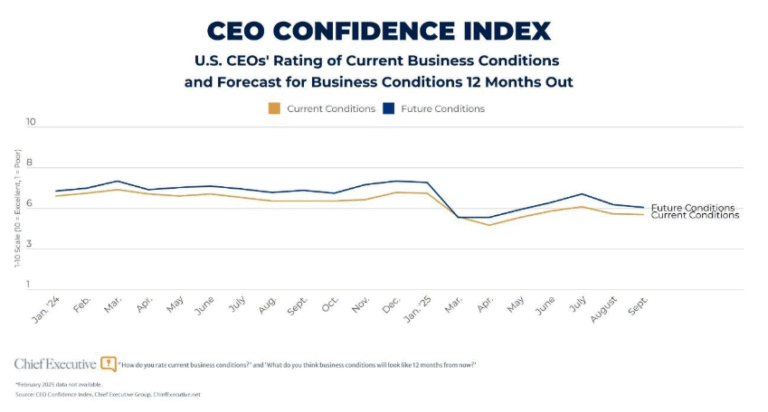
In 2008, during the last major recession, many of today’s rising business leaders were graduating college and starting their careers. Digital was in its earliest beginnings and MySpace was the third most visited social media site. The world looked different indeed!
Fast forward more than a decade, and those emerging leaders are now tasked with navigating a new reality fraught with geopolitical and economic challenges. But something else has changed too: Access to data.
To lead through an economic downturn, CEOs must tap the power of data. Nearly every business is operating in somewhat of a budget-constrained environment, so how can they ensure they’re prioritizing the most important initiatives? How can they champion projects that contribute to revenue growth?
Instead of guessing or wasting time on trial and error, data and analytics can help chart the path forward. Not only will leaders reduce strain on their resource-constricted teams, but they will also more accurately chart the course for present and future business goals than any historical models alone could predict.
For example, big-box retailers plagued by supply chain slowdowns during Covid-19 were not able to accurately predict 2022 demand because they relied on historical data alone. Because their modeling failed to account for changing customer behavior, retailers like Target struggled to move excess inventory causing them to rely on premature holiday sales to clear shelves ahead of the 2022 gifting season.
Business leaders don’t need to collect more data to bring insights into these and similar problems, they just need to analyze what they have, both internal and external data, and put those insights into action. Predictive insights can also give your business a competitive advantage. Take TikTok for example, whose stellar AI-based algorithm keeps users in the app for hours on end, or Netflix, whose recommendations have created a unique sense of virality for most-streamed shows. Strong insights about your customers make your product or service stickier.
When everything seems to be a top priority, choosing which initiatives to double down on can be as time consuming as actually executing them. To expedite the process, use insights from data to determine which initiatives are driving—and will continue to drive—revenue growth. Focus on expenditures that improve time to market, build partnerships, and enhance CX. The data will tell you what to put on the back burner.
Data is everywhere; however, a wealth of data generated daily often goes unnoticed, unanalyzed, and unused. Untapped data assets, particularly first-party data from customers, can be used immediately to make some of these mission-critical decisions. Additionally, the data will allow teams to uncover one single truth, without debate: Projects and expenditures with less revenue impact can be postponed. Every leader in the c-suite has a role to play in deploying capital efficiently. Here are a few specific areas of the business where the CEO can align with other leaders on ways to use the data to make decision making seamless:
• Procurement and Inventory Management: The biggest roadblock to streamlined procurement is the regularity at which disparate channels are used to record data and manage processes. CPOs need to move beyond Excel spreadsheets and invest in tools that add a layer of connectedness to the workflow. Such tools, like procurement software Focal Point, use your data to unearth the opportunities for seven-figure savings that are far more difficult to pinpoint without procurement unification.
• Marketing and Advertising: Historically, marketing and advertising spend has been allocated based on past-campaign performance alone. But as customer behavior changes, data that analyzes the entire customer journey becomes critical to predict product demand and anticipate changing preferences. Predictive models created with data from several marketing channels and sources (social, SEO, promotions, shipping, etc.) provide more accurate insights to create effective MMM (media mix modelling) and customer acquisition strategies.
• Technology Investments: Reining in shadow IT is becoming a high priority for CTOs and their teams. To reduce unnecessary spending, they should be judicious about what’s in their tech stack because SaaS tools are often underutilized. As leaders prepare for 2023, they should limit SaaS renewals to only those that don’t overlap with existing tools and are critical to advancing business goals. Pay close attention to the SaaS dashboards to glean all of the data possible and move marginal operational improvements to times when cash flow isn’t as much of a concern.
An exercise to help leaders use data effectively is to first identify and define a core problem. Once a problem is highlighted, teams can brainstorm possible solutions given the resources available. They should be encouraged to ask open-ended questions and think unconventionally. This will likely lead them to a data set not previously considered valuable, providing a clear advantage. How will that data prevent future missteps?
As the push for greater data democratization is in our near future, all levels should be trained and encouraged to use data regularly. Organizations that can train their employees to maximize the value of first-party data now will be well positioned to come out ahead as regulation and governance around data privacy tightens. As these measures take shape, teams should be considering other ways to gather essential data–whether from surveys, focus groups or through other methods.
Though businesses of all sizes are looking critically at their spend and having to make tough decisions about which initiatives to push forward, there are two important factors that leaders should not neglect as they continue to course correct.
First, even when budgets need to be carefully allocated, leaders should not abandon forward-thinking technology. Decentralization, crypto, Web3, and the metaverse will eventually be integrated into corporate culture—granted, maybe not in the way it looks today, but certainly the foundational technologies will come into play sooner rather than later.
In the metaverse, more and more one-on-one interactions will shift online—between humans (as consumers, employees, patients, citizens, service providers, governance agencies, and intermediaries) and machines or processes. These digital interactions generate a vast amount of granular, nuanced data that will enrich decision-making from IT to marketing teams.
Second, leaders should continue to keep a close eye on customer sentiment—letting it, above all, drive project prioritization. If you’re listening, your customers and clients will clue you in when it’s the right time to make a change. Furthermore, your customers (especially in highly impacted recession industries like BFSI) will look to you to lead them through with strong messaging and steady communication. Lean into the data to meet your customer’s unique needs and be open to responding as those needs evolve.
New leaders’ approaches to navigating through an economic downturn will vary, but it will be made easier when they rely on all the data available to understand what to prioritize. Today, guessing what the right decision should be is plain frivolous. The priority should be learning how to utilize the data available to know with relative certainty which initiatives will help weather the recessionary storm.



Chief Executive Group exists to improve the performance of U.S. CEOs, senior executives and public-company directors, helping you grow your companies, build your communities and strengthen society. Learn more at chiefexecutivegroup.com.
0

1:00 - 5:00 pm
Over 70% of Executives Surveyed Agree: Many Strategic Planning Efforts Lack Systematic Approach Tips for Enhancing Your Strategic Planning Process
Executives expressed frustration with their current strategic planning process. Issues include:
Steve Rutan and Denise Harrison have put together an afternoon workshop that will provide the tools you need to address these concerns. They have worked with hundreds of executives to develop a systematic approach that will enable your team to make better decisions during strategic planning. Steve and Denise will walk you through exercises for prioritizing your lists and steps that will reset and reinvigorate your process. This will be a hands-on workshop that will enable you to think about your business as you use the tools that are being presented. If you are ready for a Strategic Planning tune-up, select this workshop in your registration form. The additional fee of $695 will be added to your total.

2:00 - 5:00 pm
Female leaders face the same issues all leaders do, but they often face additional challenges too. In this peer session, we will facilitate a discussion of best practices and how to overcome common barriers to help women leaders be more effective within and outside their organizations.
Limited space available.

10:30 - 5:00 pm
General’s Retreat at Hermitage Golf Course
Sponsored by UBS
General’s Retreat, built in 1986 with architect Gary Roger Baird, has been voted the “Best Golf Course in Nashville” and is a “must play” when visiting the Nashville, Tennessee area. With the beautiful setting along the Cumberland River, golfers of all capabilities will thoroughly enjoy the golf, scenery and hospitality.
The golf outing fee includes transportation to and from the hotel, greens/cart fees, use of practice facilities, and boxed lunch. The bus will leave the hotel at 10:30 am for a noon shotgun start and return to the hotel after the cocktail reception following the completion of the round.